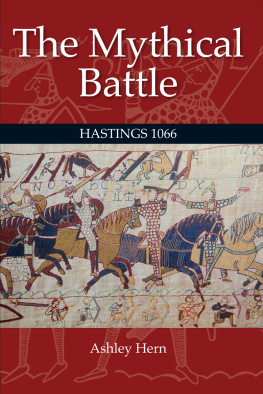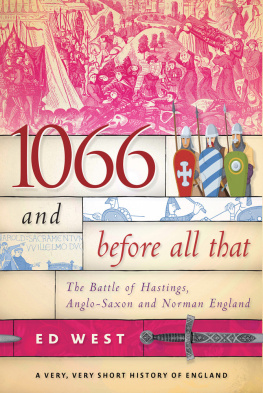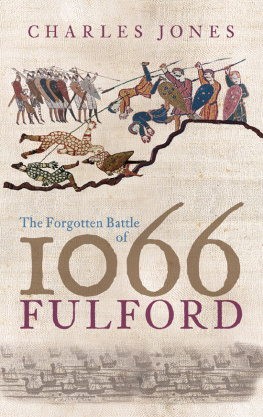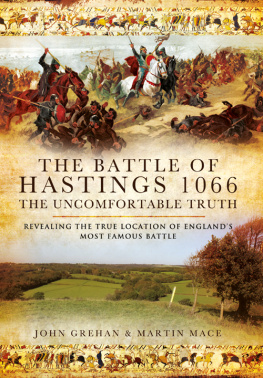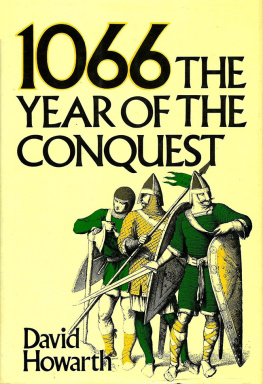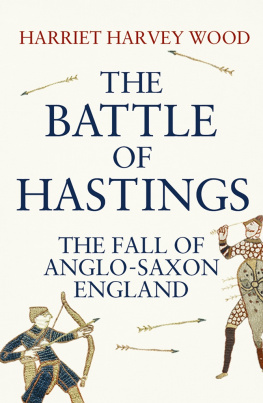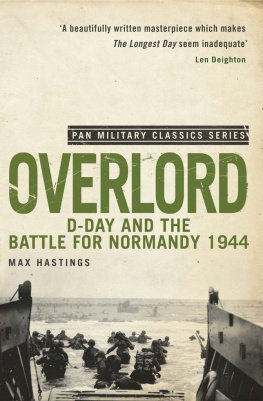
To my mother, Sarah Helena Joel
1907-2002
and to all the many friends met and made at Pyke House, Battle
C ONTENTS
6 for the Battle
W riting a book on the battle of Hastings for a medieval historian is a bit like reviewing ones life. Among the souvenirs of the past, our home is decorated with such things as Bayeux Tapestry curtains and a Bayeux Tapestry cover on a dressing table. My wife Ann and I have spent many holidays in Normandy, from Bayeux and Rouen to Caen, Falaise, Fcamp, Alenon the Conquerors footprints tread a wide path.
The project provides an opportunity to thank all those who have contributed to ones education and interests. These are many and various. They include my father who had an interest in history which probably stirred my earliest curiosity. At secondary school my interest in medieval history was first seriously sparked by Mr R.A. Dare, whom I can see now with his eyes closed and arms waving, carried away by some event from that era. At university I received much help and inspiration from Charles Duggan, who was my tutor, and Gerald Hodgett, who also taught me.
Interest turned to something more on the MA course I took as a mature student, married and with children, in London. The tutors on this course I viewed rather as friends, and their assistance was patient and changed my life. They were Christopher Holdsworth, Julian Brown, and above all Allen Brown, who went on to supervise my unfinished MPhil and PhD research. I recall an essay I wrote for Allen Brown in the early days of that course, on the battle of Hastings. I chose to praise the qualities of Harold rather than those of William as a general, for which temerity I suffered a certain amount of criticism.
Allens help is almost impossible to record, it was so varied, from teaching to advice and especially the various social occasions he supervised. I remember in particular the many evenings spent at the pub, the Marquess of Anglesey, where most I think all of my supervisions took place. There I gained much from the friendship of other medievalists, including such lifelong friends as Nick Hooper, Matt Bennett, Chris Harper-Bill and Richard Mortimer. No doubt the scene helps to explain the failure to complete the project (on warfare in Stephens reign) on which I spent eight years of part-time research, though I think in the end it was not entirely without profit.
Hastings inevitably takes one to Battle. It is impossible in one book to acknowledge all the information, help, discussion, encouragement received there. Battle means Pyke House and the Anglo-Norman Studies conference, and here another debt to Allen Brown, who initiated the conference with help from Gillian Murton and who kept it going through the rest of his life. The friends made and met at Pyke House are myriad. It was the most congenial of all meeting places, thanks to the ministrations of, among others, old Hobby and, more particularly, Peter Birch and his aides, including especially that gourmets delight, the catering head for many years, Yvonne Harris.
I have been to Pyke House times beyond counting: for the annual conference, to teach East Sussex County Council weekend courses, and to take student groups during the twenty odd years I taught at Borough Road and West London Institute. At the conferences one met virtually every historian who mattered for the Anglo-Norman period, including friends from Holland, Japan, France, Germany and the States. Outstanding among these was Warren Hollister, whose work on warfare I much admired before I met him, and who became a long-standing friend with his wife and companion at Battle, Edith.
Perhaps the first course I participated in at Pyke House was one on medieval warfare in general, which Allen organised. One of the speakers was the great later medievalist whose life came to a tragic end, Charles Ross. Allen always believed in a good lunch-time session in the pub, and as a result a number of speakers and members of the audience were rather drowsy during the afternoon sessions, not least himself. One afternoon Charles Ross was lecturing and noticed that Allen was gently snoozing in the front row. When it came to question time, a difficult point was put to him and, with malicious glee, he retorted, ALLEN ! [waking him up] what do you think about that?
The lectures at the main conferences were most valuable and are of course recorded in the Anglo-Norman Studies journal, commencing in 1978 and continuing after Allens death under the editorships of Marjorie Chibnall, Chris Harper-Bill, John Gillingham and Chris lewis. But even more valuable, to my mind, have been the social occasions: the sherry parties at the abbey and above all the drinking sessions in The Chequers, the pub next door. Who could forget in that hostelry seeing Allen Brown and Raymonde Foreville replaying the battle of Hastings on the bar billiards table, or Cecily Clark selecting her horses for the day? Numerous interesting day-trips were organised during the conferences, and these too hold many happy memories.
Pyke House was also the venue for various student trips. The attraction, of course, was in the first place its position on the battlefield of Hastings, the back garden being the best surviving slope of the hill. Here I spent many enjoyable weekends, often with students from other institutions, sharing the lecturing with friends such as Ann Williams, Chris Harper-Bill and Brian Golding, of what were then North London Poly and Strawberry Hill, and what is still Southampton University. My companion from West London on these trips was often Nick Kingwell, who would generously submerge his fifteenth-century interests to participate in these eleventh-century celebrations.
A memory that slips unbidden into ones mind is of waking in one of the pleasant bedrooms at Pyke House to open the curtains and watch the sun rising over the battlefield, of quietly going out to tramp through the dewy grass. I have always been an early riser and liked to walk into Battle to buy a Guardian , an Observer , or latterly the Independent . On many an early morning I would pass others out for their early morning constitutional, most memorably Brian Golding, the fanatical bar billiards player, whose pace at walking was twice that of any other person I have known. I accompanied him on an hours walk one morning, but only once. On other occasions one remembers Ann Williams or Christine Mahanys dogs diving into the muddy pools at the foot of the hill.
A lasting memory of Battle and Pyke House is of my friend Ian Peirce. Ian seems to have been at almost all these events: conferences, student weekends, East Sussex weekends. Sometimes indeed I shared with him the teaching of a course on the Norman Conquest. But always, usually without any recompense beyond a drink in The Chequers, Ian would perform for an audience, bringing his collection of medieval weapons, his own constructions of weapons and armour and his expertise on the subject for the benefit of all and sundry. Many, like myself, must have gained from the experience of being dressed as a Norman warrior, and I have embarrassing photos to prove it in many cases, from Simon Keynes and Marjorie Chibnall to Dominica Legge, who had to be rescued as she tottered down the hill under the weight of the armour.
In short, this for me is a book of many memories, nearly all pleasant. I should like also to thank all those involved at Sutton Publishing, at whose suggestion this book was written, in particular Roger Thorp and Jane Crompton, and for their patience and care in seeing it through; and Clare Bishop for all her hard work in editing and assembling in the final stages. For all the many other friends at Battle and elsewhere whose names I have failed to recall or mention, thanks too, and may we raise another glass in The Chequers one day soon.
Next page

